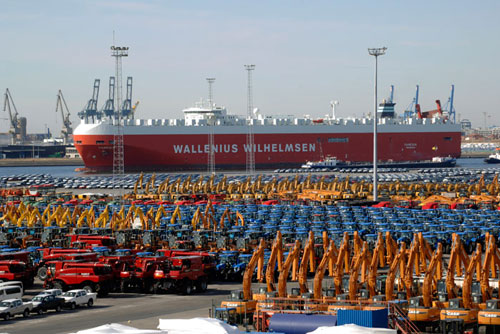|
|
|||||
7. Europe – Zeebrugge Port in Belgium

The port of Zeebrugge has an ideal location to serve the markets of continental Europe as well as the British Isles. It is a young seaport with modern port equipment suitable for the largest ships. The present structure of the port dates from as recent as 1985.
The emergence of roll-on/roll-off techniques, containerization and the increase in the scale of ships convinced the Belgian government in the 1970s to develop the coastal port into a deepwater port.
An extensive outer port and a new sea lock with entrance to an inner port gave Zeebrugge new impulses in the years that followed. As a result, total cargo traffic tripled from 14 million tonnes in 1985 to 45 million tonnes in 2009.
The port of Zeebrugge is also one of the fastest growing ports in the range of ports between Le Havre and Hamburg, which together handle more than a billion tonnes of cargo a year. Almost every product the consumer finds in shops comes through these ports. Zeebrugge has become, in only a few decades, one of the most important entry ports for the European market.
Zeebrugge has gradually developed itself into a versatile port and does not just focus on European roll-on/roll off traffic. The coastal port is also important for intercontinental (container) traffic, container feeder traffic, conventional cargo, liquefied natural gas, cruises and new cars. The unit loads, including roro and container traffic, take up three-quarters of the total cargo throughput.
Zeebrugge is a deepwater port and guarantees sufficient water depth in the access channel to the outer port and along the quays. As a result, continually larger container ships can be loaded and unloaded at any time. This competitive advantage means that the largest shipping companies in the world have Zeebrugge on their sailing schedule. Several world-renowned container operators have invested substantially in the port’s infrastructure.
In combination with a wide range of intercontinental services and good hinterland connections, Zeebrugge is especially suited for intercontinental companies to organize their European or worldwide distribution. In the meantime, quite a few companies have invested in logistics centers. From here they add value to their cargo before distributing throughout Europe.
Zeebrugge has grown from a pure transit port to a logistics platform. The role of Zeebrugge as an engine of the regional economy is growing. Today, 28,000 people have jobs, directly or indirectly, thanks to the port.